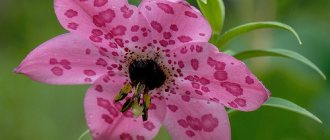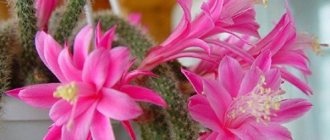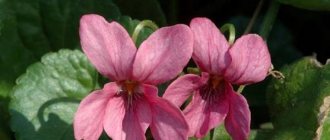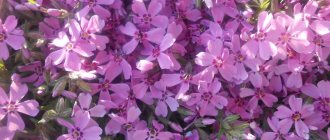Violet
This family includes mainly herbaceous perennials and annuals, as well as subshrubs and shrubs, standing and climbing plants.
There are twenty over eight hundred violet species in total, divided into twenty-eight genera. Herbs grow in the temperate zone, while shrubs and shrubs grow closer to the tropical zone. The violet leaves are bare, the upper ones are almost sessile, elongated, with stipules, the lower ones have a broadly ovate shape and long petioles. The leaf arrangement is usually alternate, sometimes biserial and very rarely opposite.
The flowers are either solitary or collected in the axils or at the ends of the shoots in panicles or racemes. Large flowers can be open or closed. In some species, the petals on a flower may have different colors and colors. Flowering usually lasts from mid-spring to autumn, and the fruits - oblong boxes, nuts or berries - begin to ripen from the beginning of summer.
It must be said that the shrub species of violets found in the Chilean Andes are so unusual that they do not at all resemble those violets that grow in our latitudes.
The most famous representatives of the Violet family can be called the amazing violet, dog violet, fragrant violet, white violet, field violet and many more species of this plant, as well as their varieties and hybrids.
Beneficial properties of tricolor violet
The presence of compounds such as flavonoids in chemicals. The composition of the shoots of this flower has a beneficial effect on the condition of blood vessels in the human body. These compounds strengthen the walls of blood vessels and prevent the occurrence of certain diseases of the cardiovascular system. Thus, flavonoids have strong antioxidant properties, thanks to which they neutralize the harmful effects of free radicals on the body. Antioxidants prevent the occurrence and development of serious cancer.
Salicylic acid has been used in medicine since the 19th century. This compound was originally extracted from willow bark and used in the treatment of rheumatism. Today, based on this substance, many medicines are made that are designed to help with a variety of diseases. Salicylic acid has anti-inflammatory properties. This compound and its derivatives can be used as antipyretic, antirheumatic and antiseptic agents. Thanks to this circumstance, the use of violets in folk medicine is so popular.
Anthocyanins are weak antiseptics. In addition, they improve the intestinal barrier properties and the functioning of the gastrointestinal tract. However, this is not all the beneficial properties of violets.
Saponins, when introduced into the body, have a slight irritant effect, which makes it easier to remove phlegm from the body. These compounds promote better effects of related drugs and compounds.
Vitamin A is a compound that the human body is unable to produce or synthesize on its own. However, this substance plays an important role in the functioning of many organs and systems of the human body. Vitamin A is involved in many important metabolic processes in the body. The absence of this compound in the diet can lead to various pathologies. The organs of vision are primarily affected. With a long-term absence of vitamin A in food, a person may lose vision.
Vitamin C, or ascorbic acid, is involved in many metabolic processes in the human body. This compound is involved in the formation of immunity, in cellular metabolic processes and is one of the most powerful antioxidants. Vitamin C neutralizes the harmful effects of free radicals on the human body. If there is a lack of this vitamin in the diet, a disease such as scurvy can occur.
Inulin is often used in medicine as a prebiotic. This compound is not digested by humans, due to which it has a beneficial effect on the state of the intestinal microflora and on some internal organs, for example the pancreas.
Viola: growing from seeds, planting and care
Author: Marina Chaika February 20, 2022 Garden plants
plant (Latin Viola) belongs to the genus of the Violet family, representatives of which grow mainly in mountainous regions and places with a temperate climate in the Northern Hemisphere and, according to various sources, number from four hundred to seven hundred species. Some of the violas are endemic to the South American Andes, and a number of them are found in the subtropics of Brazil, the tropics of South Africa, Australia, the Sandwich Islands and New Zealand. Viola is popularly known as pansy .
The violet viola has been popular since time immemorial - about two and a half millennia ago, the ancient peoples inhabiting the territory of Europe wove the flower into festive garlands and wreaths, decorating the premises for celebrations with them. The fragrant violet was the first to be introduced into culture, followed by the mountain violet. The first mention of breeding work on violet hybrids dates back to 1683. Europeans became acquainted with the Wittrock viola species, which is a hybrid of yellow viola, Altai viola and tricolor viola, in the 19th century. Today, garden viola is one of the most popular plants, with hundreds of varieties and varieties.
Violet family (Violaceae)
Life of plants: in 6 volumes. — M.: Enlightenment. Edited by A. L. Takhtadzhyan, editor-in-chief, corresponding member. USSR Academy of Sciences, prof. A.A. Fedorov. 1974.
See what “Violet family (Violaceae)” is in other dictionaries:
VIOLACEA FAMILY (VIOLACEAE) - amazing violet (and a plant with fruits); white violet; fragrant violet; dog violet; There are 18 genera and 850,900 species in the family, more than half of which belong to the Violet genus. The Violet genus has a wide range and is found in... ... Forest herbaceous plants
Related article: Fruit plants: names and photos of garden plants that bear fruit
Violaceae - ? Violet Viola banksii Scientific classification Kingdom: Plants Division: Coverings ... Wikipedia
Violet - Viola banksii ... Wikipedia
VIOLATES - order (Violates) and family (Violaceae) of dicotyledonous plants. The F. order is close to the tea and malvaceae and probably has a common origin with them from the ancestors of the Dilleniaceae. Trees, shrubs and grasses b. parts with alternate leaves with stipules ... Biological encyclopedic dictionary
Violets - (Violaceae) family of dicotyledonous plants of the order Cistiflorae. These are in most cases (Viola, Hybanthus species) annual or perennial herbs, rarely subshrubs (Viola species), erect or climbing (lianas) shrubs... ... Encyclopedic Dictionary of F.A. Brockhaus and I.A. Efron
Violets - (Violaceae) family of dicotyledonous plants. Herbs, shrubs, subshrubs, and less often small trees. The leaves are simple, usually entire, with stipules. Flowers are irregular or regular, mostly bisexual, solitary or in... ... Great Soviet Encyclopedia
Violet (violets) - ? Violet Violet tricolor (Viola tricolor) Scientific classification Kingdom: Plants ... Wikipedia
Violet - This term has other meanings, see Violet (meanings). Violet Violet tricolor (Viola tricolor) Scientific classification ... Wikipedia
List of species - List of species included in the Red Book of the Yaroslavl Region List of species included in the Red Book of the Yaroslavl Region, published in 2004. The Red Book of the Yaroslavl Region includes 14 species of mushrooms, 173 species of plants and 172 species of animals.... ... Wikipedia
List of species listed in the Red Book of the Yaroslavl Region - List of species listed in the Red Book of the Yaroslavl Region, published in 2004. The Red Book of the Yaroslavl Region includes 14 species of mushrooms, 173 species of plants and 172 species of animals. The classification is given by edition. Contents 1 Kingdom Mushrooms ... ... Wikipedia
Links
- Violets
- article from the Great Soviet Encyclopedia. - [www.mobot.org/MOBOT/Research/APweb/orders/Malpighialesweb.htm#Violaceae Violaceae
: information] on
APWeb
(English) (Accessed May 16, 2010)
When writing this article, material was used from the Encyclopedic Dictionary of Brockhaus and Efron (1890-1907).
| This is a draft article on botany. You can help the project by adding to it. |
Where are you from, pretty violet?
For many girls, growing indoor violets becomes a real hobby. The flower has a capricious disposition and needs care and regular maintenance. In a word, the violet is an amazing and at the same time very demanding beauty flower. When you fulfill all her whims and whims, the return will be maximum. Indoor plants will delight you with their stunning appearance and pleasant aroma.
- Features of Saintpaulia, its appearance
- The most extraordinary story about the origin of Saintpaulia
- We also recommend reading
- Professional gardeners - about the nuances of care
- Soil preparation for Saintpaulia and watering features
- How do plants reproduce?
Show all content
Most often, Saintpaulia is found on the windowsills of apartments, the reproduction of which does not cause serious difficulties. The flower of the plant has a blue or purple color. Violet (the plant's homeland is the countries of East Africa) has more than 20 varieties and varieties. The violet family is quite rich, so every gardener will be able to choose those types of indoor violets that will definitely suit his taste.
Related article: Scale insects and false scale insects - control on plants, types of scale insects and preparations against the pest
Features of Saintpaulia, its appearance
You already know that the birthplace of violets is Africa. Saintpaulia is a perennial plant up to 30 cm high. It has a short stem, large leaves, and an oval shape. Some types of violets have heart-shaped or elongated leaves. The color also differs - from light to dark green.
Visual photos confirm the incredible variety of colors and shapes. You can find a flower with double, corrugated, wavy or fringed petals. The average diameter is 2-4 cm, both single-color and multi-color colors are found. Night violet and Labrador violet, swamp violet and butterfly violet... It seems as if all these varieties are competing with each other in beauty.
Previously, indoor Saintpaulia had no smell and pleased gardeners solely with its appearance. As a result of long and painstaking breeding work, hybrids with a subtle, very pleasant aroma were bred.
The most extraordinary story about the origin of Saintpaulia
One of the main questions of our article is as follows: when and under what circumstances was the plant discovered? Baron Walter von Saint-Paul, who was the governor of an African state, knew exactly what a violet looked like. While exploring the Ulugur and Uzambara mountains, the researcher met a flower that captivated him with its beauty. The sky-blue radiance surprised Saint-Paul so much that he immediately wrote up a description of it and sent it to his father, a well-known orchid collector at that time.
We also recommend reading
At first, the night violet was “enlisted in the ranks” of the Gesneriaceae family.
The official year of birth of the flower was 1893, when the plant was described in detail and officially presented at an international exhibition.
Having earned recognition, the violet, whose homeland was the African continent, almost instantly adorned window sills in most countries of the world.
Professional gardeners - about the nuances of care
Planting and care have their own specifics. The plant does not like cold and reacts to it very quickly. Humidity and light are a completely different matter. But here it is important not to overdo it. For a plant such as violet, almost all species need shade if it is a hot and sunny day outside. The duration of daylight hours should be 13-14 hours.
Violet is an amazing, delicate “beauty” among other flowers. Gardeners love marsh violet, butterfly violet and some other varieties for their prolific flowering (sometimes up to 9 months). So that you can observe beautiful flowering for as long as possible, planting and care should also include sufficient lighting. To do this, creeping violet and night violet are placed on window sills that face west, east or north. Windows on the south side are also suitable, but it is advisable to place the pots on a table or shelf at the back of the room or to the side of the window.
As for temperature, the range from +18 to +24 is considered optimal. In violets, growth and reproduction deteriorate when there are changes in cold and heat in the apartment.
Pansies are rarely found in apartments and private houses (violet does not grow well in greenhouse conditions), as well as marsh violet. Preference is given to hanging varieties. They are distinguished by rather voluminous rosettes, stems falling down.
Related article: List of plants starting with the letter F: indoor, garden and vegetable gardens
General description of violets: interesting facts
The indoor violet has rightfully conquered many window sills, greenhouses and greenhouses . This small flower captivates with its compactness, aesthetics and beautiful flowering.
But still, most people mistakenly call them violets, because they have almost nothing in common with the plants that bear this name.
The official name is Saintpaulia , in some sources they are still called Uzambara violets.
So what family do violets belong to? What is the difference from Saintpaulias and how to distinguish them?
To eliminate mistakes, we will below provide a brief description of violets: interesting facts, history of origin and superstitions about these indoor plants, photos of various varieties.
All about violets
Natural habitat
The ancestors of modern indoor pets grow in Africa. The massifs of the Ulugur and Usambara (Usambara) mountains are the natural habitat of Saintpaulia , most varieties are located on the slopes of the latter and therefore received a second name, Usambara (Usambara) violet.
Violets in natural conditions.
In East Africa, violets grow in humid climates, often near waterfalls and on river terraces. In such conditions there is a lot of water dust and fog, and the soil is light and well permeable to moisture and air.
Origin story
The description of indoor plants should begin with the history of their occurrence in nature.
Walter von Saint-Paul , Commandant of the Uzambara District of German East Africa – German Colony. In 1892, while studying the flora and fauna of the territories subordinate to him, he discovered flowers in the mountains and collected seeds to understand what kind of plant it was.
They were then sent to his father, who was the president of the German Dendrological Society, Ulrich von Saint-Paul, and this is how they ended up with Hermann Wendland.
The scientist named the cultivated plant grown in 1893 Saintpaulia , and the name was given to the addition violet flower for the shape of the flower. This species was separated into a separate genus, named after the father and son who discovered it.
Next, the flower was presented at an exhibition in Goethe, where the rights to breed on a production scale were purchased by the Benari company.
Violets were brought to the USA in 1927 , and there they were recognized as ideal indoor plants. From that moment on, the mass production of new varieties began and by 1949 there were already 100 of them, and today their number is more than 32 thousand.
Biological classification
So, what is a violet from a biological point of view - is it an herbaceous plant or not? Saintpaulias are classified as a separate genus - they are evergreen herbaceous plants of the Gesneriaceae family.
The structure of an indoor violet is as follows:
- the stem is shortened, which leads to the formation of a rosette of leaves;
- the leaves are respectively arranged in rows and very close to each other;
- the leaves on the stem are round in shape, fleshy and leathery, covered with villi;
- the base of the leaves is usually slightly heart-shaped, and the apex is rounded or slightly pointed;
- The color of the leaves varies from dark to light green; they are also variegated and spotted, sometimes almost white.
Next, is the violet a monocot or a dicotyledon? The houseplant violet is bipolar . Flowers collected in racemes usually have five petals, several stamens and one pistil. The calyx consists of five sepals located on the receptacle. The violet flower pattern is shown in the picture below.
The structure of a violet flower.
After pollination, a seed capsule is formed. The seeds themselves are very small and have average germination capacity, which is lost over time.
Based on this information, you can create a passport for a houseplant:
- plant biology passport: Kingdom: plants;
- Department: flowering;
- Class: double-field;
- Order: clear-flowered;
- Family: Gesneriaceae;
- Genus: Saintpaulia;
- Application: indoor plants;
- Natural area: mountainous areas of eastern Africa.
- simplified violet plant passport for kindergarten: Kingdom: plants;
- Department: flowering;
- Genus: Saintpaulia;
- Use: indoor plants.
Variety of varieties
Indoor violet is a representative of the family of perennial herbaceous plants. It prefers small-sized pots for “life”, as it has a small root system.
Classified according to the following main characteristics:
- Characteristics of a flower usually begin with socket size:
- Micromini . The circumference does not exceed 8 cm. It is grown in light soil with good air permeability. To avoid drying out of the soil and death of the flower, a wick watering system is organized - simple and effective;
Mini - up to 14 cm. They have good germination and vitality. The rosettes have bright, rich colors. For high-quality soil moisture, it is recommended to use a “wick”;
- Semimini - up to 20 cm in diameter. The founder of this group can be called breeder I. Milekhin. The peculiarity of the variety is the fear of direct sunlight;
- Standard - from 20 to 40 cm. The most unpretentious variety.
Classification by socket size.
Classification by flower shape.
Classification by color.
It is quite difficult to answer exactly how many varieties of violets exist, since their number increases every year. More than 32,000 varieties are now known.
Often varieties are very similar to each other, but a slight difference in the shade of leaves or flowers, as well as their shape, gives rise to a new variety. In addition, a daughter individual that is slightly different from the mother, but not so much as to be a separate variety, is often called sport, for example, “Firebird sport.”
By the way, for violets, names are often given starting with capital letters, which indicate who bred this variety , for example:
Below you will see pictures of indoor plants, which show how much, and sometimes how little, different varieties differ from each other:
- LE-Champagne – terry variety, dark-leaved, fantasy color, standard size;
- LE-Blondie – a terry variety, light-leaved, two-tone color, standard size;
- RS-Ariel – variegated variety, finger-colored, standard size;
- Rob's Vanilla Trail – ampelous, dark-leaved, single-color, terry;
- Shirl's Purple Passion – variegated, classic-shaped, monochromatic flower, mini;
- N-Avatar – variegated, semi-mini, bell flower, plain.
Energy influence and superstitions
A description of indoor violets will be incomplete without mentioning their energy component. Violets are very sensitive not only to drafts from the window, but also to bad energy in the house.
In homes where there is a lot of arguing and family members suffer from mood swings and depression, violets usually bloom poorly and tend to disappear.
Violet brings peace and harmony to the house, cleanses the space of negativity . By bringing wealth into the home, it improves health and extends life expectancy.
The energy of plants depends partly on their color:
- white - purity, femininity, peace, tranquility, liberation from oppression. This color is suitable for calming, both for people in a state of aggression and for those who are emotionally very sensitive.
Dulling the feeling of anger, worries and fears, communication with a white violet brings peace. It is recommended to place white violets in rooms where children live, especially if quarrels often arise between them;
Life cycles
When buying a little baby, you always wonder how long such flowers grow. Violets grow quite quickly, from a small baby to an adult blooming violet in just six months to a year, depending on the variety.
It takes no more than a year from cutting to adult plant.
Violets are propagated by leaves, shoots and peduncles. Children from stepchildren bloom the fastest, and later than all from peduncles.
The stages of violet growth can be divided:
Shoots or stepsons are formed in the axils of the leaves. They grow quite quickly and when they reach the size of a large baby, they are removed.
Features of the plant and interesting facts about violet
Violets are very delicate, fragile and at the same time they are resistant to various irritants and changes in conditions. Saintpaulias tolerate shortcomings of care well if they are not neglected critically.
Interestingly, there are two legends about the appearance of violets on the slopes of the African mountains:
- the first legend talks about Adam's tears, which turned into Saintpaulia flowers;
- the second version is Greek - Zeus, the supreme god of Olympus, turned a nymph running away from Apollo and asking for protection into this flower.
They also believe that violets should not be placed in the house of unmarried women , because they drive men away from the house. But this sign accompanies many colors, most often without reason.
Useful videos
A very detailed video about growing violets for beginners: Watch a video with the classification of violets by size: Video review of beautiful varieties of violets: This video is dedicated to the meaning of violets for humans:
Soil preparation for Saintpaulia and watering features
Perennial violet is planted in plastic pots with a diameter of 5 to 9 cm. Due to the root system of a superficial type, it is recommended to give preference to flat pots. Loose soil that absorbs water well and allows air to pass through is suitable. The store sells a ready-made base, although you can prepare it yourself. In order for the horned chrysalis violet and the Rococo variety to grow well, it must consist of 2 parts of humus and 2 parts of turf soil, 4 parts of half-rotten foliage, pine soil, sand and charcoal (1 part each). A bucket of this mixture is mixed with half a glass of ash and superphosphate (2 tablespoons).
Be sure to run hot water over the pot before filling it with soil. This will destroy harmful microbes.
In order for the night violet to bloom profusely, as in the photo, it needs to be periodically fed with fertilizers. You can mix them directly into the soil or dilute them with water for complex watering. In the second case, the concentration decreases by 6-7 times. This will prevent the plant from burning.
Also make sure that the vetch and garden violet are not covered with white dust. This deprives the flower of its aesthetics and prevents it from developing and breathing normally.
To prevent white dust from appearing, night violet and viola are watered with warm water twice a month. It is advisable to immediately cover the soil with paper or polyethylene. It is recommended to carry out water procedures in the evening or early in the morning. The plant will be able to dry out before the first rays of the sun touch it.
For watering, use tap water, previously brought to a boil and cooled.
Soil for indoor violets at home
Caring for homemade violets involves choosing soil of a certain composition for it. A soil mixture for Saintpaulias is sold in stores, but experience shows that it is not suitable for all violets.
But universal flower soil like “Terra-Vita” is suitable for violets. You can make your own substrate from turf and leaf soil, sand and humus in a ratio of 0.5:2:1:1. You can add a tablespoon of superphosphate and half a glass of bone meal to a bucket of the finished mixture and mix everything thoroughly. The main requirements for the soil for Saintpaulias: it must be loose, quickly absorb water and allow air to pass through well.








